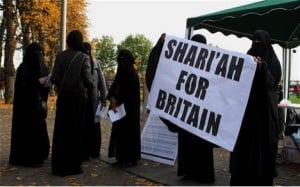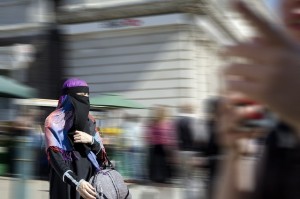Pray the Devil Back to Hell is a documentary about the women’s peace movement in Liberia, during the conflict between Charles Taylor’s government and the warlords of Liberians United for Reconciliation and Democracy (LURD). It was directed by Gini Reticker, who has directed several other documentaries about women in Africa, including a film about the first female graduates from an imam academy in Morocco. Her experience shows as she manages to avoid all the usual pitfalls outsiders usually make when making such documentaries.
The title credits of the film show a series of paintings depicting Liberian life. One of the paintings shows a church and a mosque side by side, emblematic of the events to follow.
The first person to speak in the film is Leymah Gbowee, she describes the pain and frustration of living under the war. Having reached her breaking point, she resolved to put all her efforts into working for peace. To do this, she realized she needed to network with other women and the best place to do this was during the Sunday church services. She was met with unanimous support from the women there.
They founded the Women in Peacebuilding Network and issued the following statement:
“In the past we were silent, but after being killed, raped, dehumanized, and infected with diseases, and watching our children and families destroyed, war has taught us that the future lies in saying NO to violence and YES to peace! We will not relent until peace prevails.”
Asatu Bah Kenneth is next to appear in the film. A long-serving police officer and the head of the Female Law Enforcement Association, she had been invited to hear what the women had to say. Asatu is a Muslim, and she pledged that she would call on the Muslim women of Liberia to join the effort for peace, marking the first time that Christian and Muslim women had worked together.
As the women explain, religion is more then just an identity, but a social institution and an instrument for change. Both the Christians of the Taylor regime and the Muslims of LURD could be influenced by their religious leaders if sufficient pressure was applied. The film showed women using their religious institutions instead of the usual Western/secular assumption that religion is a hindrance for women.
So Christian and Muslim women united with a simple concept: that men, either by their actions or failure to act, were causing the war. So pressure must be applied until both sides agree to peace talks.
The women achieved this by holding a long-running series of peace vigils. In churches, mosques and outside key government buildings, the women congregated, clad in the white t-shirts of the peace movement. Their numbers constantly increased until they persuaded both sides to agree to peace talks.
What makes this documentary so successful is that it is built almost entirely around the testimonies of the women involved. There is no intrusive or patronizing narration. Background information is provided by succinct captions, which means the viewer is given information without any focus being taken away from the women.
Footage depicts events without being overly graphic. The horrors of the war are conveyed via the women’s own spoken words. This is far less exploitative and certainly more moving than pieces of visual footage, as the viewer is directly connected to the emotions of those involved, rather then observing at a distance.
It is utterly awe-inspiring to see grass roots activism have such an amazing impact.











